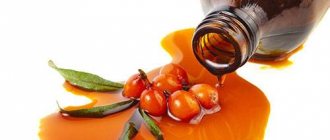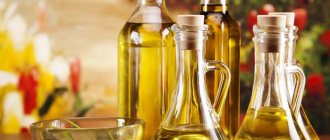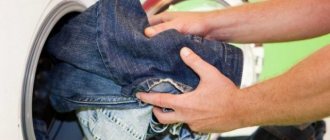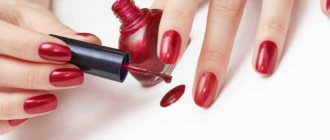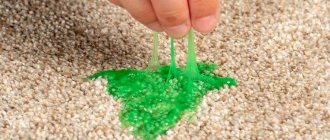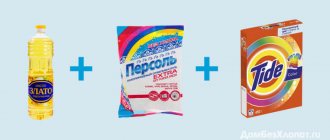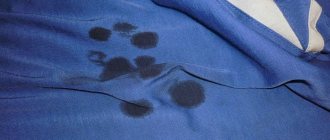To properly remove oil stains from clothes, it is important to find out the origin of these unsightly marks. Oils are divided into two large categories: household use and technical. Household products include olive, sunflower, corn, soybean, and butter. You can also add cosmetics here. And for production ones - mineral, transmission, diesel. When these substances get on clothes, they leave “blots” without an even outline, quickly becoming covered with a dusty layer. Where can you get dirty? Yes, everywhere:
- during cooking (for example, splashes from the soup scattered);
- at a festive feast;
- during street snacks (from shawarma or pies);
- in public transport;
- on rides or swings;
- while repairing the car.
Do not use turpentine, unrefined gasoline or other caustic solvents to remove oil stains. They can ruin the fabric, and after treatment a persistent specific odor will remain.
Preparatory stage and 3 cleaning rules
You shouldn’t buy the first stain remover you come across and immediately apply it to your clothes. You should first prepare the item for the procedure. First of all, the surface with the stain must be cleaned of dust with a dry brush. The oil mark should not be rubbed with powder. Follow three more recommendations.
- Work from the inside out. The cleanser is applied exclusively to the inside of the fabric.
- Make a “lining”. Before treatment, place a thick white napkin made of paper or fabric under the stained area, which will absorb greasy residue and will not allow the stain to “crawl” to the other side of the product.
- Work from the edges. To prevent the stain from starting to spread, the treatment is carried out strictly along the contour of the “blot”. You need to move from the edges to the middle.
Before the main cleaning, you can wash oil-stained clothes in the washing machine. This will remove the sticky residue. But wash at a temperature no higher than 20-30°C. At high temperatures, fat will eat into the fibers. For the same reason, you should not dry things splashed with oil on a radiator or on a heated dryer.
Hinge grease
Anti-squeak remedy.
If the doors suddenly squeak and you don’t have any special product at hand, lubricate them with a small amount of sunflower oil. However, it is worth noting that the oil will eliminate the squeak only temporarily and after a week or two the doors will creak again. So, having done this trick once, you should definitely get machine oil, grease or special lubricant and re-lubricate the door.
We choose a product depending on the type of oil...
In addition to the many ways to clean clothes from oil blots, there are those that are most suitable for certain types of stains. For example, there are tricks on how to remove machine oil from clothes at home. There are also separate recommendations if cosmetics have been spilled and for removing sunflower oil from clothes.
Vegetable
You can remove vegetable oil from clothes with chalk. Simply sprinkle on the stain and leave for half an hour, then shake off the powder and wash the item. The method works if the contamination is fresh. But you can try other options.
- Salt. The stained area is sprinkled with salt, which should be rubbed in with gentle movements. The crystals will absorb the fat.
- Bread. The crumbs are applied to a fresh stain. At the same time, the “balls” absorb the oil.
- Dish detergent. A small amount of product is applied to the stain for 15 minutes. Depending on the type of fabric, the procedure can be repeated, rinsing the product thoroughly each time.
To ensure that olive or sunflower oil is removed from the fabric, after using any of the described methods, the treated area should be soaped with laundry soap. It is also permissible to wash things with Vanish, Minutka, Sarma Active and Frau Schmidt stain removers.
Video on the topic
Machine
Technical oils include a base composition and additives. They have a dark shade and, if you miss the moment, are difficult to remove. If a “motor” stain has just appeared, immediately clean the item with a brush and throw it in the washing machine. And to remove absorbed machine oil from clothes, use kerosene. Soak a piece of cotton wool in it and thoroughly saturate the contaminated area. Let the product remain on the fabric for 30 minutes. Then rinse and wash.
Cosmetic
Cosmetic oils are no less corrosive than technical oils. Let's take sea buckthorn oil for example - such oil is difficult to remove from clothes, especially if you notice orange marks only after washing. What to use?
- Laundry soap. If you can’t start washing right away, then sprinkle the fresh “blot” with starch or soda. And then you can pour boiling water over the stain and scrub with brown soap.
- "Fairy." The item is soaked in a solution of this detergent and water.
- Vegetable oil. We use the “wedge by wedge” method. Mix 100 g of vegetable oil, washing powder and bleach. Part of the solution should be applied to the stain and rubbed a little. And the second one is to add to a basin of water where clothes are placed for soaking.
Creamy and fishy
Acetone is used to remove butter stains. You need to moisten a cotton pad in it and wipe the area of contamination from the edges to the central part. After treatment, clothes need to be washed. You can also use ammonia.
But you can remove oil stains from clothes left from canned fish using water and vinegar (1:1). The stain is washed with this composition, and then the item is sent for washing.
What not to do
The Internet is full of all kinds of advice on using bleach to remove vegetable oils from clothes. This is true, only partly. Its function does not include the dissolution or decomposition of fat. The oxygen or chlorine contained in bleaches is designed to oxidize certain substances and convert them into a soluble or colorless state. Fat is not one of these substances. Vegetable oil, on the contrary, when oxidized with oxygen, acquires the property of hardening after drying. As a result, instead of an easily removed oil stain, you can end up with a persistent stain that will remain until the end of the product’s service life.
The same applies to removing oil using hot water. In many cases, this method will cause the oil to spread over a large area and become simply a little lighter than it was to begin with.
Be careful when using plumbing cleaners. In most cases, they contain caustic, which can effectively decompose fat, but some fabrics can also easily become unusable. If there is no other way out, then you should first test the effect of the product on a small piece that will be invisible and the loss of which will not lead to irreparable consequences.
How to wash oil? This is a question that worries people who care about the cleanliness and livability of their lives. Dried oil on the floor, burnt on kitchen utensils, an old stain on clothes - all this spoils the appearance, and therefore the mood, and creates discomfort in life. That is why knowing how to wash sunflower oil is very important for every housewife.
...and by fabric type
When choosing a method for removing oil stains, you need to take into account the type of fabric. After all, what suits denim can completely ruin guipure.
- Delicate products. A jacket, dress, trousers made of silk or wool can be cleaned well even with laundry soap. You can also remove the oil with ammonia. Warm talc also absorbs such stains on sensitive materials - leave the product on for a day, and then clean it with a brush. And if the product is not machine washable, use potato starch. Rub the powder into the stained area and leave for 15 minutes.
- Things made of cotton. Alcohol is used to remove oil stains from cotton or linen fabrics. Use a cotton swab dipped in the substance to wipe the stain from the edges to the center.
- Fur. Here they also use the talc cleansing method, only a little differently than in the case of silk. You need to pour the powder onto the stain, and put transparent paper on top, which you then heat with an iron.
- Outerwear. You can treat a down jacket made of padding polyester or a jacket made of raincoat fabric with ammonia. The solution is prepared from a glass of warm water and a teaspoon of ammonia. The stain should be wiped with cotton wool soaked in the composition.
- Synthetics. If the T-shirt or sweatpants are made of synthetic fabrics, then a regular store-bought stain remover will usually remove the oil. After treating dirty areas, washing is required.
- Dense materials. For thick knitwear and jeans, you can use any of the following methods. A mixture of vinegar, ammonia and talc (1:1:1) is used to clean upholstery fabrics.
Ammonia will help not only get rid of oil stains, but also dried glue, traces of rust and mold.
Mustard for sunflower oil purification
During the difficult times of the mid-20th century, this substance was widely used to wash clothes. Modern scented cleaning products have replaced natural powders. Although mustard is still used to effectively remove food stains from kitchen towels. It copes well with oil stains.
You need to take water and mustard powder in equal proportions, mix until a thick paste is obtained and apply to a dirty surface. Wait 20-30 minutes, then clean with a soft brush. Wash clothes as usual.
How to remove old oil stains from clothes
Getting rid of a fresh oil stain on clothes is easier. Even the usual “Antipyatin” will help here. Just lather the “blot” and leave it for an hour, then wash the item as usual. But removing dried oil from clothes is more difficult, but also quite possible, even without washing the item completely. Spot-treat the stain with a mixture of ammonia, cold water and fine table salt (1:1:1). If the contamination persists, try one of the following methods.
- Mustard powder. The product must be mixed with water until creamy. It is recommended to wash the item before cleaning. Then the powder is applied to the dirty area for five minutes, after which the mark is rubbed with laundry soap and washed off.
- Refined gasoline. For example, “Galoshes”. A piece of cloth is generously moistened in the solution and placed under the contaminated area. The stain is wiped from above with a clean material. Then the item should be washed.
- Salt. Half a glass of salt is added to a basin of hot water and the dirty item is placed there. You need to leave it for a couple of hours. Then the product can be washed using powder and stain remover.
When choosing a method for removing oil from clothes, always take into account the type of material, type of oil and the aggressiveness of the products used. You can experiment with thick fabrics: one composition does not work - wash the item and try another. But it’s better to save expensive items made from delicate fabrics and outerwear and have them dry cleaned.
How to clean dishes from burnt vegetable oil
Quite often, housewives who care about the health of their family refuse universal detergents and prefer traditional methods of cleaning kitchen utensils. How to clean a pot or frying pan from burnt oil? An effective and proven method over the years is as follows:
- prepare a mixture of baking soda with the addition of hydrogen peroxide;
- apply the mixture to areas contaminated with grease;
- let the dishes with the applied mixture stand for 40 minutes;
- remove grease using kitchen sponges;
- Rinse the dishes under running water.
The same mixture can be used to clean tiles and floors from vegetable oil. For kitchen furniture, a different mixture is used, which simultaneously removes stains and polishes the surface. To make your furniture look clean and well-groomed, rub it with a mixture made from soda and a few tablespoons of oil with the addition of natural oils. With such cleaning, the furniture regains its original appearance, is cleared of stains, and the air is filled with pleasant aromas.
Shine of metal surfaces
Means for polishing metal surfaces.
To make cutlery, stainless steel kitchen utensils and faucets shine again, wipe them from time to time with a napkin soaked in sunflower oil. In addition, oil forms a thin, greasy film on the surface of objects, which will protect these objects from contamination for a long time.

